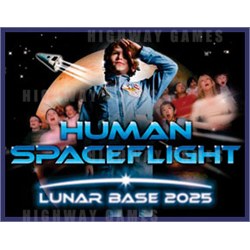This summer sees the launch of 'Human Spaceflight: Lunar Base 2025' at the National Space Centre in Leicester. This new gallery was designed by Leicester-based agency, Haley Sharpe, and leading academics in the field to present a glimpse into the future. Drawing on the latest thinking from the European Space Agency and NASA, the team behind the project have promulgated what could be achieved in terms of space exploration with the technology that should be available twenty years hence. Prof. Alan Wells of The University of Leicester, part of the team behind Human Spaceflight: Lunar Base 2025, said, "During the next 20 years Human Exploration of Space will be resumed on a scale not seen since the Apollo Moon landings of over 30 years ago. Apollo excited people of all ages, all around the world, at that time. This new era of space exploration is as challenging as Apollo and will, we believe, have a major impact on the lives and interests of generations of young people for whom Apollo is ancient history. As space scientists, we have tried to project our imaginations, and use our knowledge of new technologies, to help the Space Centre show how astronauts will work and train on the Moon in 2025. We have compressed a year long training mission, including a simulated flight to Jupiter's Moon Europa, to allow visitors to the Space Centre to anticipate the experiences of the next generation of space explorers."
Upon entering the gallery, visitors will receive their boarding passes and briefing for a realistic astronaut training mission. Here all the future technology deployed is explained, as well as the reasons behind the training programme, that of preparing for exploration of Jupiter's Moon, Europa. As Jupiter has such high levels of radioactivity, it is envisaged that a remotely created base has been built one mile beneath the ice of Europa to shield the explorers as they carry out their experiments. The large craft in which the astronauts will travel is launched without chemical fuel, relying on electro magnetic accelerators instead. This "Gauss Gun" effect is used to shoot the spacecraft into orbit around the Moon's surface using a pulsing magnetic rail gun about five kilometres in length. As it leaves the Moon's surface, it will have reached five times the speed of sound. At this point, the craft will engage its engines, which have plasma-based fuel cells, and enter lunar orbit. All of this is represented in 3D thanks to an advanced visualisation system designed and installed by Virtalis, Europe's leading Virtual Reality specialists. These images are perfectly in synch with a hydraulic platform that realistically produces the gravity forces experienced by the crew.
The explorers are then fast-forwarded to the closing stages of their mission, where the craft, which is cruising at 100,000 kilometres per hour, uses Newton's Laws and the atmosphere of Jupiter to slow down. It then heads to Europa using the last of its fuel to slow as it does so. As Europa has no atmosphere, a thrilling ride ensues, as it crashes through ice canyons on the way to the base below the ice. Owing to the radiation levels, the crew are aware that they only have three minutes to land before the radiation dose becomes too dangerous. This deadline is only just met and the doors of the base slam behind the craft, ending the spaceflight experience.
Andy Gregory, Creative Services Manager for the Production Department at The National Space Centre, said, "Our facility involves both physical movement and stereoscopic images, to create a believable future simulation technology. There are very few theatres offering this level of realism anywhere in the world. We turned to Virtalis to help us design the installation because their experience is unparalleled and we knew they could supply a turnkey system using their StereoWorks package. Our show concept took us four months to develop, but we now have the building blocks in place for us to begin work on another one. We want to capture people's imagination by presenting science and education in an exciting and memorable way."
Source: Press release,
KWP Limited.




